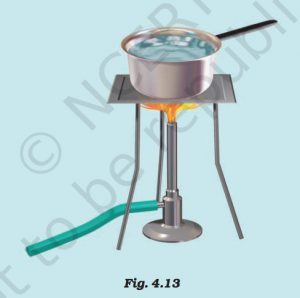NCERT Solutions for Chapter 4 Heat for Class 7
Question 1. State similarities and differences between the laboratory thermometer and the clinical thermometer.
Answer 1 Similarities
1) Both are made of long, narrow uniform glass tubes.
2) Bulbs of both the thermometers contain mercury.
3) Both have Celsius and Fahrenheit scale.
4) Both are used to measure temperature.
| Laboratory thermometer | Clinical thermometer |
| It is used to measure temperature of different objects in factories and laboratory | It is used to measure the temperature of human beings only |
| It has a temperature range from −10℃ to 110℃ | It has a temperature range from 35℃ to 42℃. |
| It has to be kept upright while taking the reading | It can be tilted while taking reading. |
Question 2. Give two examples each of conductors and insulators of heat.
Answer 2 Conductors: Copper, aluminium
Insulators: Wood, water
Question 3. Fill in the blanks :
(a) The hotness of an object is determined by its __________.
(b) Temperature of boiling water cannot be measured by a _____________ thermometer. (c) Temperature is measured in degree ______________.
(d) No medium is required for transfer of heat by the process of __________.
(e) A cold steel spoon is dipped in a cup of hot milk. Heat is transferred to its other end by the process of ______________.
(f) Clothes of ______________ colours absorb more heat better than clothes of light colours.
Answer 3 (a) The hotness of an object is determined by its temperature.
(b) Temperature of boiling water cannot be measured by a clinical thermometer.
(c) Temperature is measured in degree Celsius.
(d) No medium is required for transfer of heat by the process of radiation.
(e) A cold steel spoon is dipped in a cup of hot milk. It transfers heat to its other end by the process of conduction.
(f) Clothes of dark colours absorb heat better than clothes of light colours.
Question 4. Match the following :
(i) Land breeze blows during (a) summer
(ii) Sea breeze blows during (b) winter
(iii) Dark coloured clothes are preferred during (c) day
(iv) Light coloured clothes are preferred during (d) night
Answer 4
(i) Land breeze blows during (d) night
(ii) Sea breeze blows during (c) day
(iii) Dark coloured clothes are preferred during (b) winter
(iv) Light coloured clothes are preferred during (a) summer
Question 5. Discuss why wearing more layers of clothing during winter keeps us warmer than wearing just one thick piece of clothing .
Answer 5 We wear more layers of clothing during winter to keep us warm than wearing just one thick piece of clothing because air gets trapped in between the layers and as we know that air is a bad conductor, it does not allow the body heat to escape out.
Question 6. Look at Fig. 4.13. Mark where the heat is being transferred by conduction, by convection and by radiation.
Answer 6
Question 7. In places of hot climate it is advised that the outer walls of houses be painted white. Explain.
Answer 7 Because white colour reflects most of the heat that falls on it or we can say it absorbs less amount of heat. Therefore, the temperature inside the house does not increase very much.Therefore outer walls of houses are painted white in places with hot climate.
Question 8. One litre of water at 30°C is mixed with one litre of water at 50°C. The temperature of the mixture will be
(a) 80°C
(b) more than 50°C but less than 80°C
(c) 20°C
(d) between 30°C and 50°
Answer 8 (d) between 30°C and 50°C
Question 9. An iron ball at 40°C is dropped in a mug containing water at 40°C. The heat will
(a) flow from iron ball to water.
(b) not flow from iron ball to water or from water to iron ball.
(c) flow from water to iron ball.
(d) increase the temperature of both.
Answer 9 (b) not flow from iron ball to water or from water to iron ball.
Question 10. A wooden spoon is dipped in a cup of ice cream. Its other end
(a) becomes cold by the process of conduction.
(b) becomes cold by the process of convection.
(c) becomes cold by the process of radiation.
(d) does not become cold.
Answer 10 (d) does not become cold.
Question 11. Stainless steel pans are usually provided with copper bottoms. The reason for this could be that
(a) copper bottom makes the pan more durable.
(b) such pans appear colourful.
(c) copper is a better conductor of heat than the stainless steel.
(d) copper is easier to clean than the stainless steel.
Answer 11 (c) copper is a better conductor of heat than the stainless steel.


Leave a Reply